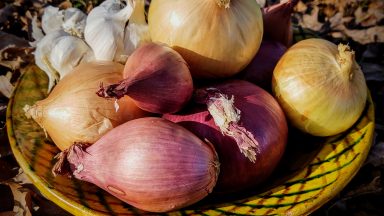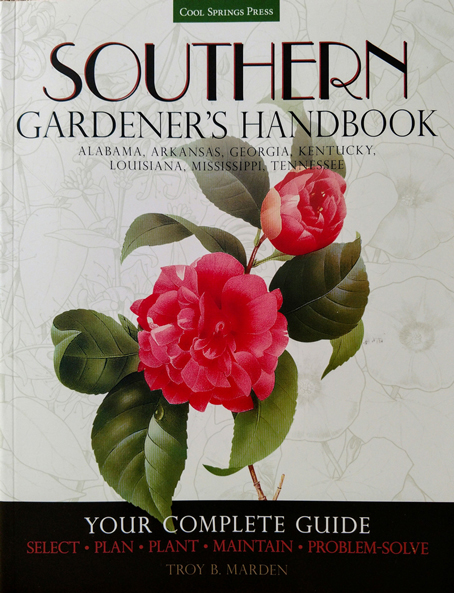
I am a big fan of Mimi Thorisson. In her book, A Kitchen In France, she mentions that a friend asked her once what she would do if there were no onions and notes that she had no answer at the time and still doesn’t. She goes on to describe onions as “the eggs of the vegetable world, endlessly versatile, and can be bit players in big dishes or leading stars in French classics like onion soup.” I could not agree more.
Onions are endlessly versatile and something you will never find my kitchen without. There is nearly always a bowl of onions at the ready on my kitchen counter and if I get down to fewer than 6 “backups” in the pull-out bin in the cupboard next to the stove, I get nervous. Seriously. Whether they are the pungent reds, thinly sliced for adding to a burger or quick pickled in the fridge to amp up a salad, the classic French shallot whose mild flavor adds depth and complexity to sauces, gravies, and any number of other dishes, or the classic southern “Vidalia”–available only for a few months each year–adding its sweet perfection to onion soup (it’s not all French, by the way), the onion is without a doubt in the Top 5 ingredients in my kitchen.
To me, onions are no less important than good quality salt and pepper, the best olive oil you can afford (yes, there’s a huge difference in quality and flavor), equally good wine in both red and white (if you wouldn’t drink it, why would you cook with it?), and a selection of basic herbs and spices including thyme, rosemary, bay leaf, and fresh garlic (there are plenty of other herbs and spices in the pantry, but these are the ones I couldn’t cook without, year-round). Tied in with that group of basics would be at least three kinds of prepared mustard in the fridge and some good vinegar in case you need to whip up a quick vinaigrette on the spur of the moment, but more about that in another post.
Types of Onions
If we really dove deep into a discussion of types of onions, it’s likely that many of you would give up and stop reading halfway through, so I’m going to spare you some of the minutest details and focus primarily on onions and their close kin that are found regularly at the market and a few which, if you garden, you should look into. They’re one of the easiest crops to grow and if you’re willing to go to a little extra effort by starting with seed, you can up your onion game considerably and everyone will think you are a true gourmand.
Red, Yellow, and White Standard Onions
By “standard” onions, I mean the everyday market varieties that are part of every produce section in more or less any grocery store you might walk into. Red onions are, perhaps, the most versatile of all of the onions; enough sweetness and a low enough sulfur content (sulfur is what makes onions pungent and brings tears to your eyes) to make them a useful raw ingredient, and a medium to low water content that makes them stand up well to cooking without becoming mush. They can even be cooked long enough, with the addition of a few other ingredients, to turn them into a savory/sweet jam that is the perfect condiment to accompany certain cheeses (Piave Vecchio from Italy, for one, as well as a good, well-aged Pecorino) and a variety of beef and pork dishes. Yellow onions are what I would consider your basic cooking onion and are great for soups, stews, mirepoix (the “holy trinity” of Cajun and Creole cooking, “soffritto” of Italy, and part of the “sofrito” of Spanish cooking), and perfect for long, slow cooking with roasts. While any onion can be eaten raw, standard yellow varieties tend to be the most pungent and, perhaps, the least desirable as a raw ingredient. White onions are considered the classic onion by many cooks and most would tell you they are among the sweetest. While true, they can also be incredibly pungent, depending on the climate and soil in which they were grown. They can be eaten both raw and cooked, but because of the variance in sulfur content and thus, their heat and pungency, it’s always a good idea to check one prior to serving them up raw to guests.
Sweet Onions
Sweet onions were initially represented–at least in the U.S.–by the mild, sweetly flavored, almost candy-like onions that are grown in Vidalia County, Georgia, certain parts of Texas, and the Walla Walla region of Washington state. Today, Vidalia is probably the best-known of these types due to advances in storage that have led, in the past three decades or so, to their nationwide distribution. Because of their comparatively short shelf-life, they were largely unknown outside of the southern U.S. until the 1970’s even though they have been grown in Vidalia County and surrounding regions since 1931. Vidalia is not a cultivar name (in fact, as of 2014 there were more than 25 individual approved cultivars that can receive the “Vidalia” moniker), but rather a production region where the climate and soil provides just the right combination to raise onions with a very high concentration of sugar and very low sulfur content, making for what many consider the perfect onion for raw consumption. Today, this is closely monitored and regulated much like the DOP, DOCG, and other regulatory marks you find on many authentic Italian products. The original sweet onions came to the United States from Italy and Spain and were imported through Bermuda, becoming widely known as “Bermuda onions”. Today’s Vidalia onions, as well as “Texas Sweet”, “Maui”, and “Walla Walla” varieties all derived from these original imports. There are other regions now producing sweet onions, as well, including in Central and South America, which is where many of them are imported from during the winter months–the off-season for the U.S. crops.
Other Delicious and Interesting Onions and Close Relatives
Cipollini, literally “small” or “tiny” onions are the small, flattened onions (cipolle) of Italy famous for being turned into the sweet and sour Cipollini in Agrodolce (recipe follows). The best cipollini are under 2 inches in diameter and not more than 3/4-inch thick. Another famous Italian onion hails from Calabria, in the far south of Italy. The Tropea onion, like the Vidalia onion in the U.S., borrows its name from the area in which it is grown–the high cliffs of Tropea along the Tyrrhenian Sea as you head down the coast toward the toe of the Italian boot. Known in Italy as la regina rossa–the red queen–the torpedo-shaped, bright red onion called cipolla da serbo, harvested in June, is the best-known of the Tropea varieties, but the April-harvested, reddish-purple cipolla fresca and the sweet, white-bulbed cipollotto complete what is actually a Tropea onion trio. The shallot is not a true onion (it’s a different species), but is used in much the same way as many onions. Raw, it has a sharp, but pleasant flavor and is an important ingredient in many good vinaigrettes. Cooked, it is popular for flavoring sauces and gravies because it is a very “melty” onion and with a little sauteing, will essentially disappear, leaving behind only its flavor in whatever you have combined it with. Pearl onions, or cocktail onions, are popular for cooking whole with roasts and other meat dishes, where they release their mild onion flavor, but also develop a superb sweetness. They are also very popular for pickling whole as an accompaniment to charcuterie or, perhaps, in a martini glass. Scallions, or green onions, are best used raw as a garnish or to add an earthy onion flavor to fresh salads. They are a rather flimsy onion and while they can be sauteed, they do not caramelize well and become rather slick and slimy when cooked. I generally try to avoid cooking with them, although I do like their flavor incorporated into a nice meatloaf.
***If you are interested in growing your own onions, there are several ways to go about it. For standard onions of the red, white, and yellow varieties, the easiest method is to plant onion “sets” (small, starter bulbs) in early spring. Plant them approximately 2 inches deep and 2 inches apart. As they grow, harvest every other one for use as green onions and allow the others to grow to maturity. Shallot sets may also be found in early spring and are planted from small starter bulbs like standard onions. Sweet onions of the Vidalia-type are typically grown from live starts that look a great deal like scallions when you plant them. These need very well-drained soil and generally won’t thrive in extremely heavy clay. Most sweet varieties are also short-day, winter-growing onions, so are typically grown only in regions (south Georgia, Texas, Washington state) where prolonged bouts of extremely cold winter weather are rare. This makes it more difficult for the home gardener in much of the U.S. to grow these types successfully. In milder regions, very early spring planting may be successful, with harvesting before the extreme heat of summer sets in. For the Italian types of onions–Cipollini, Tropea, and others–seed is the way to go. You will need to start them in small, individual cells in flats in early spring (like you would buy 6-packs of flowers in during spring). They don’t appreciate root disturbance, so growing them in individual cells reduces root damage when you transplant them. All onions need full sun and plenty of water when they are in active growth. Fertilizing with a high phosphorous fertilizer that promotes bulb development may be helpful, but be careful about products that contain sulfur. It can be assimilated by the roots, stored in the bulbs, and, as you learned above, sulfur compounds are what makes your onions very pungent and even “hot”.
I had better stop here with the conversation and move on to a recipe before I’ve lost your attention entirely. Below, you will find one of my favorite, if somewhat time-consuming, side dishes. They are delicious on their own and even better when served with a nice beef or pork roast, steak, and other meat dishes. This recipe makes 12 servings and can easily be halved. However, I almost like these better the next day (or two) when they have had even more time to absorb their delicious balsamic vinegar dressing, so I rarely make a half batch. Just reheat them a bit in a skillet on the stove. Delicious! (If you can’t find true cipollini onions at your grocery, you can substitute pearl onions, although there is even more peeling involved.)

Cipollini in Agrodolce
3 pounds cipollini or pearl onions, root end trimmed (Trim just enough to remove the roots, but leave the base of the bulb intact. Leave skins on. You’ll skin them later.)
2 Tablespoons extra virgin olive oil
1 bay leaf
1/2 teaspoon dried thyme
2/3 cup red wine vinegar
1/2 cup dry red wine (not cooking wine)
2 1/2 Tablespoons sugar
2 1/2 teaspoons salt
Freshly ground pepper
Bring a large pot of water to a boil. Add the onions, reduce the heat to medium-low, and simmer for 15 minutes to soften the outer layers of the onions. Drain completely and allow to cool. When they’re cool enough to handle, carefully peel the onions removing only the skin and the outermost layer just under it, if it is in poor condition.
Add the olive oil with the bay leaf to a large skillet or saute pan and heat until hot, but not smoking. Add half of the onions and 1/4 teaspoon of the dried thyme, stirring occasionally for 5-7 minutes or until the onions are at least partly browned (they won’t brown all over, but should be a deep, golden brown in spots). Use a slotted spoon to transfer the first batch to a bowl and then add the remaining half of the onions and 1/4 teaspoon of thyme to the pan, repeating the procedure. Return the first batch of onions to the pan with the second batch.
Stir together the vinegar, wine, sugar, and salt and add it to the pan. Reduce the heat to medium-low and cook, stirring occasionally, until the liquid reduces, becomes syrupy, and clings to the onions. This may take up to 20 minutes. Keep a close eye on the liquid as it reduces, as it can scorch and become bitter. Serve warm or at room temperature.


